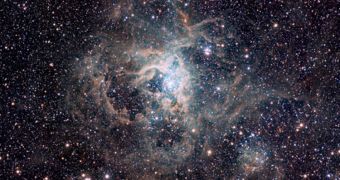Astronomers with the European Southern Observatory (ESO) have recently produced an impressive new image of the Tarantula Nebula, a stellar nursery in the Large Magellanic Cloud. The photo was snapped as part of the VISTA Magellanic Cloud survey the experts were conducting in the galaxy.
Over the past year or so, the Tarantula Nebula has been imaged in extensive detail on several occasions, mostly due to the fact that it presents an easy target. The LMC is located very close to the Milky Way, which makes it a target of opportunity for astronomers. And the ESO crew has the equipment it needs for conducting such observations.
The new data sets cover not only the stellar nursery itself, but also a large area of the sky around it, which is very rich in stars. The photograph was snapped in near-infrared wavelengths, and it catches the very essence of the beautiful nebula. The new study was part of a larger survey.
Experts at ESO want to survey the galaxies closer to home thoroughly. They also want to gain additional data on the state of the “environment” these cosmic structures are surrounded with. The survey is extremely ambitious, and it will take a while until it's completed.
“This view is of one of the most important regions of star formation in the local Universe – the spectacular 30 Doradus star-forming region, also called the Tarantula Nebula,” says astronomer Maria-Rosa Cioni, who is based at the University of Hertfordshire, in the United Kingdom.
“At its core is a large cluster of stars called RMC 136, in which some of the most massive stars known are located,” says the expert, who was also the leader of the ESO survey team. The new data were collected with the VISTA telescope, a fresh addition to the Paranal Observatory, in Chile.
“The VISTA images will allow us to extend our studies beyond the inner regions of the Tarantula into the multitude of smaller stellar nurseries nearby, which also harbor a rich population of young and massive stars,” says VISTA Magellanic Cloud Survey (VMC) expert Chris Evans.
“Armed with the new, exquisite infrared images, we will be able to probe the cocoons in which massive stars are still forming today, while also looking at their interaction with older stars in the wider region,” he adds. It is estimated that the VMC will take about 5 years to complete.
Unlike other IR telescopes, the Visible and Infrared Survey Telescope for Astronomy can cover much larger swaths of the night sky.

 14 DAY TRIAL //
14 DAY TRIAL //